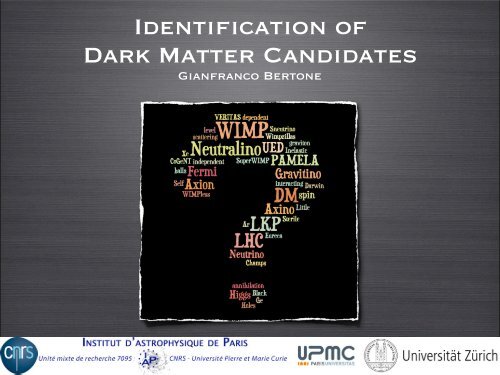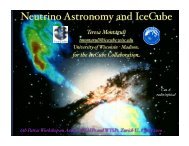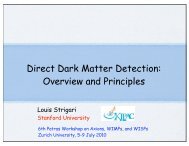Identification of Dark Matter Candidates
Combined analysis direct/indirect/accelerators - axion-wimp 2010
Combined analysis direct/indirect/accelerators - axion-wimp 2010
You also want an ePaper? Increase the reach of your titles
YUMPU automatically turns print PDFs into web optimized ePapers that Google loves.
<strong>Identification</strong> <strong>of</strong><br />
<strong>Dark</strong> <strong>Matter</strong> <strong>Candidates</strong><br />
Gianfranco Bertone
Particle <strong>Dark</strong> <strong>Matter</strong>:<br />
Search Strategies<br />
Colliders<br />
Direct Detection<br />
Indirect Detection
Beyond the Standard Model<br />
The Standard Model provides an accurate description <strong>of</strong> all known particles and interactions,<br />
however there are good reasons to believe that the Standard model is a low-energy limit <strong>of</strong> a<br />
more fundamental theory<br />
Gauge Bosons<br />
Higgs<br />
Leptons<br />
Quarks<br />
To explain the origin <strong>of</strong> the<br />
weak scale, extensions <strong>of</strong> the<br />
standard model <strong>of</strong>ten<br />
postulate the existence <strong>of</strong><br />
new physics at ~100 GeV<br />
New theory<br />
(SUSY, Extradim,<br />
etc.)<br />
WIMP?<br />
c s<br />
t b<br />
Extension <strong>of</strong> SM<br />
Energy<br />
On the left, schematic view <strong>of</strong><br />
the structure <strong>of</strong> possible<br />
extensions <strong>of</strong> the standard<br />
model<br />
Standard<br />
Model<br />
Particles<br />
B<br />
W<br />
H<br />
g<br />
e<br />
μ<br />
τ<br />
ν e<br />
ν µ<br />
ν τ<br />
u d<br />
Standard Model
Beyond the Standard Model<br />
The Standard Model provides an accurate description <strong>of</strong> all known particles and interactions,<br />
however there are good reasons to believe that the Standard model is a low-energy limit <strong>of</strong> a<br />
more fundamental theory<br />
Gauge Bosons<br />
Higgs<br />
Leptons<br />
Quarks<br />
To explain the origin <strong>of</strong> the<br />
weak scale, extensions <strong>of</strong> the<br />
standard model <strong>of</strong>ten<br />
postulate the existence <strong>of</strong><br />
new physics at ~100 GeV<br />
New theory<br />
(SUSY, Extradim,<br />
etc.)<br />
WIMP?<br />
c s<br />
t b<br />
Extension <strong>of</strong> SM<br />
Energy<br />
On the left, schematic view <strong>of</strong><br />
the structure <strong>of</strong> possible<br />
extensions <strong>of</strong> the standard<br />
model<br />
Standard<br />
Model<br />
Particles<br />
B<br />
W<br />
H<br />
g<br />
e<br />
μ<br />
τ<br />
ν e<br />
ν µ<br />
ν τ<br />
u d<br />
Standard Model
Beyond the Standard Model<br />
The Standard Model provides an accurate description <strong>of</strong> all known particles and interactions,<br />
however there are good reasons to believe that the Standard model is a low-energy limit <strong>of</strong> a<br />
more fundamental theory<br />
Gauge Bosons<br />
Higgs<br />
Leptons<br />
Quarks<br />
New theory<br />
(SUSY, Extradim,<br />
etc.)<br />
WIMP?<br />
c s<br />
t b<br />
Extension <strong>of</strong> SM<br />
Energy<br />
Search at LHC for processes like e.g.<br />
Standard<br />
Model<br />
Particles<br />
B<br />
W<br />
H<br />
g<br />
e<br />
μ<br />
τ<br />
ν e<br />
ν µ<br />
ν τ<br />
u d<br />
Standard Model
Searching for New Physics at the LHC
B<br />
Example <strong>of</strong> Inverse problem at LHC<br />
Inferring the relic density (thus the DM nature) <strong>of</strong> newly<br />
discovered particles from LHC data... What we would like:<br />
a<br />
Ad. from Baltz, Battaglia, Peskin, Wizansky (2005)
Example <strong>of</strong> Inverse problem at LHC<br />
(example in the stau coannihilation region, 24 parms pMSSM)<br />
MCMC as<br />
implemented in the<br />
SuperBayes code<br />
Benchmark in the co-anihilation region<br />
(similar to LCC3 in Baltz et al.). Errors<br />
correspond to 300 fb-1. Error on mass<br />
difference with the stau ~10% for this<br />
model can be achieved with 10 fb-1
Example <strong>of</strong> Inverse problem at LHC<br />
what we will most probably get<br />
(example in the stau coannihilation region, 24 parms MSSM)<br />
GB, Cerdeno, Fornasa, Ruiz de Austri & Trotta, 2010
Example <strong>of</strong> Inverse problem at LHC<br />
what we will most probably get<br />
(example in the stau coannihilation region, 24 parms MSSM)<br />
GB, Cerdeno, Fornasa, Ruiz de Austri & Trotta, 2010
Direct Detection<br />
Principle and Detection Techniques<br />
Detector<br />
Baudis 2007<br />
n<br />
χ<br />
DM Scatters <strong>of</strong>f nuclei in<br />
the detector<br />
Detection <strong>of</strong> recoil energy via<br />
ionization (charges), scintillation<br />
(light) and heat (phonons)
Direct Detection<br />
95% C.L. constraint on the reconstructed DM mass<br />
∼25 kg <strong>of</strong> Ge, 1 yr<br />
∼150 kg <strong>of</strong> Ge, 1 yr<br />
∼10 3 kg <strong>of</strong> Ge, 1 yr<br />
Adapted from Green 2008<br />
σχn = 10 -8 pb; Nev ~ 20, 120, 800 at mχ= 50 GeV
Direct Detection<br />
Basics<br />
DM Scatters <strong>of</strong>f nuclei<br />
in the detector<br />
Differential Event Rate<br />
Detector<br />
SUSY: squarks and Higgs<br />
exchange<br />
n<br />
χ<br />
UED: 1st level quarks and<br />
Higgs exchange
Direct Detection<br />
Basics<br />
DM Scatters <strong>of</strong>f nuclei<br />
in the detector<br />
Differential Event Rate<br />
Detector<br />
Theoretical Uncertainties<br />
Ellis, Olive & Savage 2008; Bottino<br />
et al. 2000; etc.<br />
n<br />
χ<br />
Uncertainties on f(v)<br />
Ling et al. 2009; Widrow et al. 2000;<br />
Helmi et al 2002
Direct Detection<br />
Uncertainties on the Local Density<br />
“Statistical”<br />
Ullio & Catena 2009<br />
“Systematic”<br />
Pato, Agertz, GB, Moore & Teyssier 2010<br />
+<br />
From dynamical Observables (see<br />
also Strigari & Trotta 2009)<br />
w/ Baryons<br />
DM only
LHC+DD<br />
σxn<br />
LHC<br />
DD<br />
Mx
LHC+DD<br />
σxn<br />
LHC<br />
DD<br />
Mx
LHC+DD<br />
σxn<br />
LHC<br />
DD<br />
Mx
LHC+DD<br />
σxn<br />
LHC<br />
DD<br />
Mx
LHC+DD<br />
To combine LHC and DD:<br />
•Specify DM experiment<br />
•add new likelihood built on<br />
the number <strong>of</strong> events<br />
•re-run the chains<br />
•(note that Fixing the number<br />
<strong>of</strong> events = fixing the product<br />
<strong>of</strong> cross section times local<br />
density)<br />
GB, Cerdeno, Fornasa, Ruiz de Austri & Trotta (2010)
1st possibility:<br />
“consistency check”
2nd (more physical) possibility:<br />
“Scaling” Ansatz
Indirect Detection<br />
Gamma-ray telescopes<br />
•Ground Based (CANGAROO,<br />
HESS, MAGIC, MILAGRO, VERITAS)<br />
•Space satellite FERMI<br />
•Plans for a future Cherenkov<br />
Telescope Array<br />
Neutrino Telescopes<br />
•Amanda, IceCube<br />
•Antares, Nemo, Nestor<br />
•Km3<br />
Anti-matter Satellites<br />
•PAMELA<br />
•ATIC,PPB-BETS<br />
•AMS-02<br />
Other<br />
•Synchrotron Emission<br />
•SZ effect<br />
•Effect on Stars
Cosmic e + e -<br />
PAMELA, HESS, Fermi, ATIC, PPB-BETS, HEAT,<br />
AMS, Caprice...<br />
Grasso et al. 2009<br />
Grasso et al. 2009
The trouble with indirect searches<br />
...which means that the “inverse problem” always admits a<br />
solution, even when the data have nothing to do with DM!
The quest for the smoking-gun<br />
or<br />
“How to convince a particle<br />
physicist?”
The quest for the smoking-gun<br />
or “How to convince a particle physicist?”<br />
Claims <strong>of</strong> discovery have been made over the years (EGRET source, HEAT excess, INTEGRAL 511 keV line,<br />
WMAP Haze). The footprint <strong>of</strong> DM could be anywhere, but how do we go from “hints” to “discovery”?
The quest for the smoking-gun<br />
or “How to convince a particle physicist?”<br />
Claims <strong>of</strong> discovery have been made over the years (EGRET source, HEAT excess, INTEGRAL 511 keV line,<br />
WMAP Haze). The footprint <strong>of</strong> DM could be anywhere, but how do we go from “hints” to “discovery”?<br />
1) Annihilation Lines (or other unmistakable spectral features)<br />
Neutralinos (e.g. Bergstrom and Ullio 1997)<br />
KK <strong>Dark</strong> <strong>Matter</strong> in UED (Bringmann et al. 2005)<br />
Inert Higgs DM (Gustafsson et al. 2007)<br />
gravitinos in SUSY with R-parity violation (GB, Buchmueller, Covi & Ibarra 2008)<br />
WIMP FOREST! GB, Jackson, Tait & Vallinotto 2009
The quest for the smoking-gun<br />
or “How to convince a particle physicist?”<br />
Claims <strong>of</strong> discovery have been made over the years (EGRET source, HEAT excess, INTEGRAL 511 keV line,<br />
WMAP Haze). The footprint <strong>of</strong> DM could be anywhere, but how do we go from “hints” to “discovery”?<br />
1) Annihilation Lines (or other unmistakable spectral features)<br />
Neutralinos (e.g. Bergstrom and Ullio 1997)<br />
KK <strong>Dark</strong> <strong>Matter</strong> in UED (Bringmann et al. 2005)<br />
Inert Higgs DM (Gustafsson et al. 2007)<br />
gravitinos in SUSY with R-parity violation (GB, Buchmueller, Covi & Ibarra 2008)<br />
WIMP FOREST! GB, Jackson, Tait & Vallinotto 2009<br />
2) Multiple Sources with Identical spectra<br />
e.g. DM clumps or IMBHs
The quest for the smoking-gun<br />
or “How to convince a particle physicist?”<br />
Claims <strong>of</strong> discovery have been made over the years (EGRET source, HEAT excess, INTEGRAL 511 keV line,<br />
WMAP Haze). The footprint <strong>of</strong> DM could be anywhere, but how do we go from “hints” to “discovery”?<br />
1) Annihilation Lines (or other unmistakable spectral features)<br />
Neutralinos (e.g. Bergstrom and Ullio 1997)<br />
KK <strong>Dark</strong> <strong>Matter</strong> in UED (Bringmann et al. 2005)<br />
Inert Higgs DM (Gustafsson et al. 2007)<br />
gravitinos in SUSY with R-parity violation (GB, Buchmueller, Covi & Ibarra 2008)<br />
WIMP FOREST! GB, Jackson, Tait & Vallinotto 2009<br />
2) Multiple Sources with Identical spectra<br />
e.g. DM clumps or IMBHs<br />
3) High-Energy Neutrinos from the Sun<br />
Icecube, Antares, km3<br />
Fluxes proportional to SCATTERING not annihilation cross section
The quest for the smoking-gun<br />
or “How to convince a particle physicist?”<br />
Claims <strong>of</strong> discovery have been made over the years (EGRET source, HEAT excess, INTEGRAL 511 keV line,<br />
WMAP Haze). The footprint <strong>of</strong> DM could be anywhere, but how do we go from “hints” to “discovery”?<br />
1) Annihilation Lines (or other unmistakable spectral features)<br />
Neutralinos (e.g. Bergstrom and Ullio 1997)<br />
KK <strong>Dark</strong> <strong>Matter</strong> in UED (Bringmann et al. 2005)<br />
Inert Higgs DM (Gustafsson et al. 2007)<br />
gravitinos in SUSY with R-parity violation (GB, Buchmueller, Covi & Ibarra 2008)<br />
WIMP FOREST! GB, Jackson, Tait & Vallinotto 2009<br />
2) Multiple Sources with Identical spectra<br />
e.g. DM clumps or IMBHs<br />
3) High-Energy Neutrinos from the Sun<br />
Icecube, Antares, km3<br />
Fluxes proportional to SCATTERING not annihilation cross section<br />
4) Multi-wavelength / multi-messenger approach<br />
Bertone, Sigl & Silk 2001; Aloisio, Blasi & Olinto 2004; Colafrancesco, Pr<strong>of</strong>umo & Ullio 2005;<br />
Regis & Ullio 2007, Jeltema and Pr<strong>of</strong>umo 2008 etc.
The quest for the smoking-gun<br />
or “How to convince a particle physicist?”<br />
Claims <strong>of</strong> discovery have been made over the years (EGRET source, HEAT excess, INTEGRAL 511 keV line,<br />
WMAP Haze). The footprint <strong>of</strong> DM could be anywhere, but how do we go from “hints” to “discovery”?<br />
1) Annihilation Lines (or other unmistakable spectral features)<br />
Neutralinos (e.g. Bergstrom and Ullio 1997)<br />
KK <strong>Dark</strong> <strong>Matter</strong> in UED (Bringmann et al. 2005)<br />
Inert Higgs DM (Gustafsson et al. 2007)<br />
gravitinos in SUSY with R-parity violation (GB, Buchmueller, Covi & Ibarra 2008)<br />
WIMP FOREST! GB, Jackson, Tait & Vallinotto 2009<br />
2) Multiple Sources with Identical spectra<br />
e.g. DM clumps or IMBHs<br />
3) High-Energy Neutrinos from the Sun<br />
Icecube, Antares, km3<br />
Fluxes proportional to SCATTERING not annihilation cross section<br />
4) Multi-wavelength / multi-messenger approach<br />
Bertone, Sigl & Silk 2001; Aloisio, Blasi & Olinto 2004; Colafrancesco, Pr<strong>of</strong>umo & Ullio 2005;<br />
Regis & Ullio 2007, Jeltema and Pr<strong>of</strong>umo 2008 etc.<br />
5) Angular power Spectrum <strong>of</strong> EG Background<br />
Ando & Komatsu 2006, Ando et al. 2007; Siegal-Gaskins 2008; Fornasa, GB et al. 2008<br />
Fermi Guest Investigator Grant!
Even in case <strong>of</strong> detection, the precise determination<br />
<strong>of</strong> DM will be a tricky issue<br />
indirect neutrino signals vis-a-vis direct detection recoil rates<br />
Serpico & GB, 2010
Conclusions<br />
•Huge Theoretical and experimental effort<br />
towards the identification <strong>of</strong> DM<br />
•LHC is running! Exciting times ahead, but<br />
direct and indirect searches likely necessary<br />
to identify DM<br />
•DM Direct Detection looks promising, but info<br />
from other exps. is needed to determine DM<br />
parameters<br />
•DM Indirect Detection more and more<br />
constrained, but detection still possible<br />
•We Need Data! In ~5 Yrs. discovery <strong>of</strong> Wimps or<br />
Paradigm shift..
Prospects for detecting neutrinos from SUSY DM<br />
annihilations in the Sun<br />
Halzen & Hooper 2009
Deriving Exclusion Plots<br />
I. Take a numerical simulation
Deriving Exclusion Plots<br />
I. Take a numerical simulation
Constraints from CMB<br />
on the ann. cross section at recombination, i.e. v/c~10 -8<br />
(cfr. Talks by Iocco and Hector on Monday)<br />
Galli, Iocco, GB, Melchiorri 2009<br />
The interaction <strong>of</strong> secondary particle from DM annihilation with the<br />
thermal gas can 1: ionize it, 2: induce Ly–α excitation <strong>of</strong> the hydrogen and<br />
3: heat the plasma. The first two modify the evolution <strong>of</strong> the free electron<br />
fraction xe, the third affects the temperature <strong>of</strong> baryons.
Constraints from CMB<br />
on the ann. cross section at recombination, i.e. v/c~10 -8<br />
Slatyer, Padmanabhan, Finkbeiner 2009<br />
The interaction <strong>of</strong> secondary particle from DM annihilation with the<br />
thermal gas can 1: ionize it, 2: induce Ly–α excitation <strong>of</strong> the hydrogen and<br />
3: heat the plasma. The first two modify the evolution <strong>of</strong> the free electron<br />
fraction xe, the third affects the temperature <strong>of</strong> baryons.




